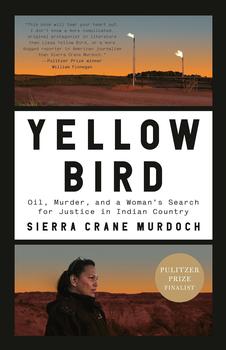Summary | Excerpt | Reviews | Beyond the Book | Read-Alikes | Genres & Themes | Author Bio

Oil, Murder, and a Woman's Search for Justice in Indian Country
by Sierra Crane MurdochThis article relates to Yellow Bird
 When most people hear the word "casino," they think of slot machines trilling and the tinny crashing of coins. But there is a deeper significance to gambling, especially as it pertains to casinos located on federal Indian reservations. While a fun pastime for many, casinos are the lifeblood for the Native American tribes across the country who own and operate them. But how much do casino riches contribute to the wealth and welfare of all Native Americans?
When most people hear the word "casino," they think of slot machines trilling and the tinny crashing of coins. But there is a deeper significance to gambling, especially as it pertains to casinos located on federal Indian reservations. While a fun pastime for many, casinos are the lifeblood for the Native American tribes across the country who own and operate them. But how much do casino riches contribute to the wealth and welfare of all Native Americans?
The reality is quite different from the pervasive myth of the "rich Indian" who merely opens his hand to catch the falling money from booming casino and resort profits. Indeed, of the federally recognized tribes (a prime requirement for casino ownership on reservations), the number that operate casinos and resorts is much smaller than many people think. Complex legal regulations along federal, state and tribal lines often further obfuscate the issue.
Indian gaming, as it was called in its early years, began in the 1970s with Florida tribes operating small bingo halls. In 1988, Congress passed the Indian Gaming Regulatory Act (IGRA) to help regulate Indian gaming within the states. The act sought to ensure tribes were the primary beneficiary of all gaming revenue, that they were operating free of corruption, and that they were not infiltrated by organized crime.
Many federally recognized Indian tribes seized this opportunity to build casinos and resorts on their reservations to gain a level of sovereignty through economic stability denied Native Americans for so long. But where does this perception of money flowing freely into every Indian's hand come from? One possibility is the example of the Shakopee Mdewakantan Tribe in Minnesota, arguably the richest Native American tribe in the nation. They own and operate the fourth largest casino in America, the Mystic Lake Casino Hotel. Along with a second operation, the Little Six Casino, the Shakopees generate annual revenue of more than $1 billion. A relatively small tribal nation, this translates into each member receiving more than $1 million a year. The windfall also goes back into the community, however, as mandated by the IGRA. With its surfeit of profits, the Shakopee Mdewakantan Nation generously donates and provides grants and loans to other Native American tribes.
But this is the rare example of Native American wealth being spread equitably, an exception that does not prove the rule. Indeed, many people erroneously assume that every tribe owns a casino. According to a National Indian Gaming Commission (NIGC) fact sheet, of the 567 federally recognized tribes, 238 operate gaming facilities, leaving 58 percent of tribes who do not have access to casinos and the attendant revenue. Even among the tribes who do own casinos, not every Indian receives money from the earnings. According to Indian Country Today, tribal nations are bound by strict IGRA rules about what they can do with their net profits. A percentage must go "to improve [the tribe's] infrastructure, develop education opportunities, and provide social programs for the people." While some 72 percent of tribes do send out per capita payments, they are generally on the smaller side.
While many tribes benefit from casino and resort operations (the Shakopee Mdewakantan Tribe being an extreme example), by far, most Native Americans still must cope with high levels of unemployment and a poverty cycle they cannot escape. The myth of "Indian casino riches" acts as a barrier to understanding the true picture of Native American economic instability and poverty. Sadly, it doesn't appear this long-lived myth will cash in its chips anytime soon.
Mystic Lake Casino Hotel, courtesy of Mystic Lake
Filed under Places, Cultures & Identities
![]() This "beyond the book article" relates to Yellow Bird. It originally ran in April 2020 and has been updated for the
February 2021 paperback edition.
Go to magazine.
This "beyond the book article" relates to Yellow Bird. It originally ran in April 2020 and has been updated for the
February 2021 paperback edition.
Go to magazine.
Your guide toexceptional books
BookBrowse seeks out and recommends the best in contemporary fiction and nonfiction—books that not only engage and entertain but also deepen our understanding of ourselves and the world around us.